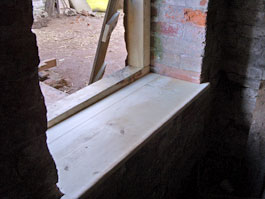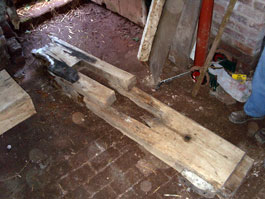Best viewed in landscape
Watermill Blog - The Hurst Problem
4th March 2008
It was a lovely sunny morning when the team met today, if a little crisp. The low temperature encouraged us to get on with some work, if only to keep warm.

Kim and Headley finished the window frame they had worked on last week and with a bit of bricklaying help from John they soon had it fixed in the smaller ground floor window.
This window is more of a hatchway to the gear pit and will be fitted with solid timber shutters, opening outward. Richard has made a start on making these. The timber sill had completely decayed, crumbling to dust as soon as it was touched, so a replacement was fitted from the same dimension timber.
John and Jonathan joined forces to work on the north wall of the stable, repairing the brickwork at ground level. Many years without any guttering has meant that rain has eroded the mortar to the point that bricks could fall out of the wall. This is awkward work and not very photogenic but it needs to be done.

Colin and Dave took the time to have a thorough review of what we can do to repair the hurst.
The hurst can be thought of as a four legged table that supports the millstones. Two of the legs are bolted to the outside wall of the mill nearest the waterwheel.
One of these two is sound but the other has decayed badly where the damp has been trapped between the wood and the wall. At some time in the past this leg has been repaired with the addition of another large piece of oak. This repair has also decayed badly. The picture shows the original leg to the right with the repair lying half on top of it to the left. Both pieces have been removed and are shown lying on the floor of the mill while we think about the problem.
Because the original leg is almost hollow with decay we don't think that we can just repeat the old repair, it just wouldn't go high enough give enough reinforcement. We think we can re-use the top twelve to fourteen inches of the original leg and preserve some of the quirky fixtures at the top but we are beginning to think that we will have to replace the rest of it with new timber.
This is a bit of a shame because the old repair is part of the mill's history, but the risk of the millstones falling through the floor is not one we are prepared to take. We can save the old timbers and put them on display so that visitors can still see them and understand the problem.
It's one thing to work out what we must do but actually doing it is going to be a major task. These are big pieces of oak that we need to shape and then manouver into position. Not a job to be done in a day, but it will probably generate a lot of content for this watermill blog.
Go to the next Watermill Blog entry
Go to the previous Watermill Blog entry
Learn how to Support Us
Return to our Home Page